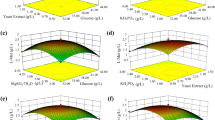Abstract
In this study, the fed-batch fermentation technique was applied to improve the yield of l-threonine produced by Escherichia coli TRFC. Various fermentation substrates and conditions were investigated to identify the optimal carbon source, its concentration and C/N ratio in the production of l-threonine. Sucrose was found to be the optimal initial carbon source and its optimal concentration was determined to be 70 g/L based on the results of fermentations conducted in a 5-L jar fermentor using a series of fed-batch cultures of E. coli TRFC. The effects of glucose concentration and three different feeding methods on the production of l-threonine were also investigated in this work. Our results showed that the production of l-threonine by E. coli was enhanced when glucose concentration varied between 5 and 20 g/L with DO-control pulse fed-batch method. Furthermore, the C/N ratio was a more predominant factor than nitrogen concentration for l-threonine overproduction and the optimal ratio of ammonium sulfate to sucrose (g/g) was 30. Under the optimal conditions, a final l-threonine concentration of 118 g/L was achieved after 38 h with the productivity of 3.1 g/L/h (46% conversion ratio from glucose to threonine).








Similar content being viewed by others
References
Leuchtenberger, W. (1996). Bio/Technology, 6, 465–502.
Kim, Y. H., Park, J. S., Cho, J. Y., Cho, K. M., Park, Y. H., & Lee, J. (2004). The Biochemical Journal, 381, 823–829. doi:10.1042/BJ20031763.
Lee, M. H., Lee, H. W., Park, J. H., Ahn, J. O., Jung, J. K., & Hwang, Y. I. (2006). Journal of Bioscience and Bioengineering, 101, 127–130. doi:10.1263/jbb.101.127.
Debabov, V. G. (2003). Advances in Biochemical Engineering/Biotechnology, 79, 113–136. doi:10.1007/3-540-45989-8_4.
Song, K. H., Lee, H. H., & Hyun, H. H. (2000). Applied Microbiology and Biotechnology, 54, 647–651. doi:10.1007/s002530000417.
Okamoto, K., & Ikeda, M. (2000). Journal of Bioscience and Bioengineering, 89, 87–89. doi:10.1016/S1389-1723(00)88057-3.
Kim, K. A., Noh, B. S., Lee, J. K., Kim, S. Y., Park, Y. C., & Oh, D. K. (2000). Journal of Microbiology and Biotechnology, 10, 69–74.
Kim, J. I. H., & Yoo, Y. J. E. (2002). Journal of Microbiology and Biotechnology, 12, 617–621.
Li, Y., Chen, J., Mao, Y. Y., Lun, S. Y., & Koo, Y. M. (1998). Process Biochemistry, 33, 709–714. doi:10.1016/S0032-9592(98)00038-7.
Zhu, M., Yu, L.-J., Li, W., Zhou, P.-P., & Li, C.-Y. (2006). Enzyme and Microbial Technology, 38, 735–740. doi:10.1016/j.enzmictec.2005.07.025.
Okamoto, K., & Ikeda, M. (2000). Journal of Bioscience and Bioengineering, 89, 87–89. doi:10.1016/S1389-1723(00)88057-3.
Xiufu, H., Daidi, F., Yane, L., Xi, Z., Huijuan, S., Yu, M., Xiaoxuan, M., an, S. L., & Guifang, Z. (2006). Chinese Journal of Chemical Engineering, 14, 242–247. doi:10.1016/S1004-9541(06)60065-7.
Andersson, C., Hodge, D., Berglund, K. A., & Rova, U. (2007). Biotechnology Progress, 23, 381–388. doi:10.1021/bp060301y.
Yang, R. Y. K., & Su, J. (1993). Bioprocess and Biosystems Engineering, 9, 97–102.
Clarke, K. G., Hansford, G. S., & Jones, D. T. (1988). Biotechnology and Bioengineering, 32, 538–544. doi:10.1002/bit.260320417.
Horntvedt, B.R., Rambekk, M., & Bakke, R. (1998). Water Science and Technology, 37, 259–262. doi:10.1016/S0273-1223(98)00117-6.
Ying Lin, H., & Neubauer, P. (2000). Journal of Biotechnology, 79, 27–37. doi:10.1016/S0168-1656(00)00217-0.
Weber, A. E., & San, K. Y. (1988). Biotechnology Letters, 10, 531–536. doi:10.1007/BF01027124.
Bin, F. Z., Yang, W. D., Yang, X. Q., Yi, W. T., & Ning, C. (2006). China Biotechnology, 26, 54–58.
Acknowledgments
We thank Hui Liu and Guo-qiang Zhang for critical reading of this manuscript and providing valuable suggestions. This work was supported by the National High Technology Research and Development Program of China (Grant No.2006AA02Z216).
Author information
Authors and Affiliations
Corresponding author
Electronic Supplementary Material
Below is the link to the electronic supplementary material.
ESM 1
(DOC 42.5 KB)
Rights and permissions
About this article
Cite this article
Chen, N., Huang, J., Feng, Zb. et al. Optimization of Fermentation Conditions for the Biosynthesis of l-Threonine by Escherichia coli . Appl Biochem Biotechnol 158, 595–604 (2009). https://doi.org/10.1007/s12010-008-8385-y
Received:
Accepted:
Published:
Issue Date:
DOI: https://doi.org/10.1007/s12010-008-8385-y




